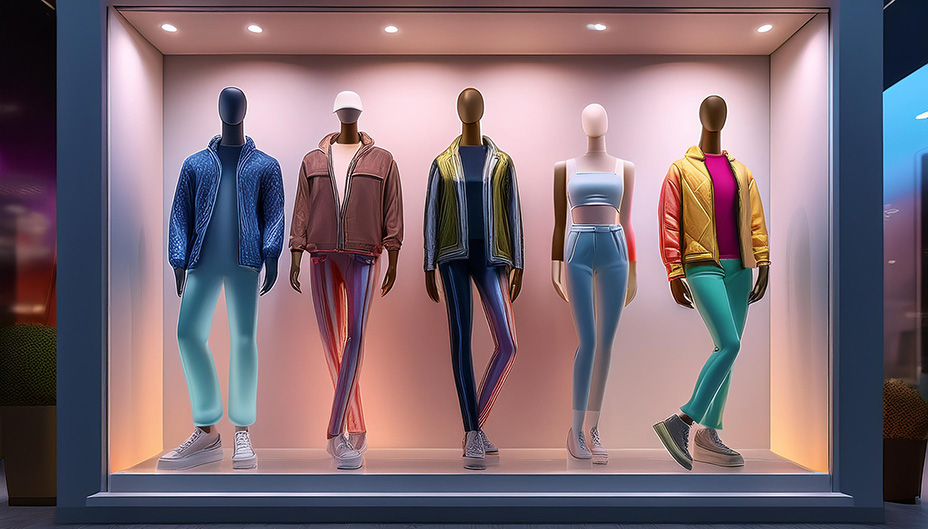An Investor’s Guide to Luxury Retail and Sporting Goods
Written by The Inspired Investor Team | Published on December 10, 2024
Written by The Inspired Investor Team | Published on December 10, 2024
Knowing whether wide-leg or low-rise jeans are the hot new style can keep you on trend, but it could also help you make investment decisions. While the trendiness of a company’s products is hardly the only factor determining share performance, having personal knowledge of the retail landscape – not to mention a love of shopping – could benefit an investor.
We look at some of the many factors to think about when considering investing in two key parts of this market: luxury retail and sporting goods.
Thinking about luxury goods
The personal luxury goods market, which includes companies such as LVMH, Hermès and Burberry, has historically grown annual revenues in the single digits, and expanded by 7 per cent between 2009 and 20191, says Piral Dadhania, a luxury sector equity analyst at RBC Capital Markets. (Some luxury goods companies, including internationally listed ones, are available to trade through RBC Direct Investing – learn more about international trading.) “If you have improving standards of living and wealth creation, then the pie [of the luxury market] gets bigger,” he says. “In theory, there’s an endless conveyor belt of new customers coming into this category.”
The sector’s rise, however, has not been smooth. Interest in high-end fashion soared during the pandemic, when consumers who were restricted from spending money in restaurants and other in-person activities started buying pricier items online. As that spending dissipated post-pandemic, the industry’s revenue growth has moved closer to 4 or 5 per cent, according to RBC estimates. “The industry recruited a lot of new buyers, many of whom ended up being aspirational and transient customers,” Dadhania says.
At the same time, China, which drove a lot of demand for luxury items in the 2010s and still accounts for about 30 per cent of the revenue mix, has run into significant economic issues2, putting a drag on consumer spending. Rising global inflation has also hit luxury goods particularly hard. RBC estimates that prices have increased on average about 50 per cent since 2019, Dadhania says, which has turned some aspirational consumers away.
Then there are the fashion trends themselves. Post-pandemic fashion has become more conservative, Dadhania says. Consumers are less keen to show off their wealth, he explains. The brands themselves are also more focused on creating ready-to-wear clothing with a more contemporary style rather than the risk-taking, fashion magazine-headlining items that made these businesses household names. “It has to appeal to a wider customer base.”
The sector may get a lift if a number of recent developments improve consumer confidence around the globe. Chinese consumers could potentially benefit from domestic stimulus measures Beijing is putting in place to buoy the economy. Declining interest rates may improve sentiment among North American and European consumers. U.S. consumers, in particular, are in a good position to boost the sector as asset prices of stocks and real estate have largely held up over the last couple of years,, bolstering net wealth, Dadhania says.
The sporting goods story
Sports-related apparel, like that from brands such as Adidas, Nike and Lululemon, is seeing average annual revenue growth at a steady 6 per cent3, but it too is undergoing a shift that investors should note.
Starting in the 2010s, people embraced what Dadhania calls the “casualization of life”, as sports, style and fashion converged. Many people stopped wearing suits to the office, donned sneakers instead of dress shoes, and traded in pants and shirts for sweatsuits. The pandemic sent this trend into overdrive, with sweatpants becoming nearly everyone’s work-from-home uniform.
Since pandemic-era restrictions eased though, this trend has shifted, Dadhania says. Rather than just going for comfort, more health-conscious consumers now want sports clothing that can actually enhance their performance in physical activities. “You have the technically focused brands outperforming the lifestyle-focused brands,” he says. “There’s more demand for performance product you actually do exercise in, rather than product that you just look good in.”
With some predicting that the health and exercise industry will continue to grow4, demand for these products could continue to expand, too. Still, it’s an extremely competitive landscape, Dadhania says, and some smaller companies are able to grow at a faster rate than some of the more established, widely held brands.
Do your due diligence
Historically, companies with the best brands in their respective categories have performed well, Dadhania says. In the luxury segment, that often includes businesses with strong heritage and history in categories like jewelry and leather. These categories tend to have more universal appeal than luxury-brand ready-to-wear clothing or footwear, which are typically more niche.
Good management is also important, Dadhania says , especially in the sporting goods sector, where brand and marketing can make or break a business. “You need a CEO in place who understands the product.” Of course, you may also want to keep an eye on the catwalk to see how fashion trends are progressing. “Some of this just comes down to getting the fashion cycle right,” Dadhania says.
Like window shopping on Rodeo Drive, there’s no harm in window shopping for stocks, but be mindful of impulse purchases. Do your homework, and maybe some research at the mall. Consider current trends, consumer demand, economic growth, the likelihood of new competitors, and the quality of management in your stock-picking decisions. Unlike that sweater that doesn’t quite fit, stocks don’t come with a money-back policy if you’re not 100 per cent satisfied with your purchase.
1. Source - Bain & Company, "Luxury Stumbles in 2024 but Can Still Return to Solid Growth", November 2024
2. Source - Reuters, "China consumer is epitome of delayed gratification", November 2024
3. Source - S&P Global, "Sector Update: Sportswear", June 2024
4. Source - Fortune Business Insights, "Health and Fitness Club Market Size, Share and COVID-19 Impact Analysis, By Type (Personal Training, Group Training, and Self-Training), By Age Group (Up to 20 Years, Between 20 and 40 Years, 40 to 55 Years, and Over 55 Years), and Regional Forecast 2023-2030", November 2024
RBC Direct Investing Inc. and Royal Bank of Canada are separate corporate entities which are affiliated. RBC Direct Investing Inc. is a wholly owned subsidiary of Royal Bank of Canada and is a Member of the Canadian Investment Regulatory Organization and the Canadian Investor Protection Fund. Royal Bank of Canada and certain of its issuers are related to RBC Direct Investing Inc. RBC Direct Investing Inc. does not provide investment advice or recommendations regarding the purchase or sale of any securities. Investors are responsible for their own investment decisions. RBC Direct Investing is a business name used by RBC Direct Investing Inc. ® / ™ Trademark(s) of Royal Bank of Canada. RBC and Royal Bank are registered trademarks of Royal Bank of Canada. Used under licence.
© Royal Bank of Canada 2025.
Any information, opinions or views provided in this document, including hyperlinks to the RBC Direct Investing Inc. website or the websites of its affiliates or third parties, are for your general information only, and are not intended to provide legal, investment, financial, accounting, tax or other professional advice. While information presented is believed to be factual and current, its accuracy is not guaranteed and it should not be regarded as a complete analysis of the subjects discussed. All expressions of opinion reflect the judgment of the author(s) as of the date of publication and are subject to change. No endorsement of any third parties or their advice, opinions, information, products or services is expressly given or implied by RBC Direct Investing Inc. or its affiliates. You should consult with your advisor before taking any action based upon the information contained in this document.
Furthermore, the products, services and securities referred to in this publication are only available in Canada and other jurisdictions where they may be legally offered for sale. Information available on the RBC Direct Investing website is intended for access by residents of Canada only, and should not be accessed from any jurisdiction outside Canada.
We asked three people how they created financial independence and retired early
We break down why you might want to consider investing in the sweet ingredient
We look at the cost of getting away, and whether your money could be better invested for the future